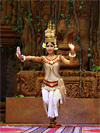|
Apsara Dance
The
Khmer equivalent of
Khon, i.e. Thai Classical Dance (fig.), in
Cambodia. It is named after the
Apsara (fig.), i.e. female divinities or nymphs, that in Khmer mythology perform as the celestial dancers of the Tavatimsa Heaven, and whom in art are often depicted in murals and lintels (fig.), and in statues (fig.) which nowadays have become sought-after souvenirs. Akin to Khon, it makes use of
arm and
hand positions (mudra) in
combination with the
position of the legs, feet and body (ram tha) to express different
situations,
thoughts and feelings, a concept known in Khmer as kbach (ក្បាច់), derived from rba kbach (របាំក្បាច់), which literally means ‘dance choreography’. However, the
term kbach is also used for Khmer design and ornaments in art and architeture, as well as for poses in other circumstances, from meditation to erotica (fig.). These graceful slow gestures and poses are usually taught from an early age onward (fig.), usually by means of certain figurative concepts, e.g. the picking of a fruit, in which the hand is brought upward and then down, as if picking a fruit from a tree, or the spreading out of flower leaves on the floor, in which the hand and arm make a movement suggestive of disseminating flower leaves. The poses may also be named or referred to after these symbolic movements. However, they do not necessarily represent the meaning that needs to be conveyed, but rather act as a mnemonic. Dancers usually wear a
sampot
(fig.), i.e. the traditional, sarong-like
lower garment and national dress of Cambodia for both men and women. Becoming an Apsara dancer is often a way out of poverty for the rural poor as well as for orphans. Also known as Rba Kbach Khmer (របាំក្បាច់ខ្មែរ), i.e. ‘Khmer Dance’. The subdistrict of Nang Ram (นางรำ), i.e. the ‘Dancing Lady,’ in
Thailand's
Nakhon Ratchasima Province, has thematic
street lanterns of Apsara Dancers in reference to the name of this
tambon. See also POSTAGE STAMPS, TRAVEL PICTURE, and THEMATIC STREET LIGHT (1)
and (2).
回






|

